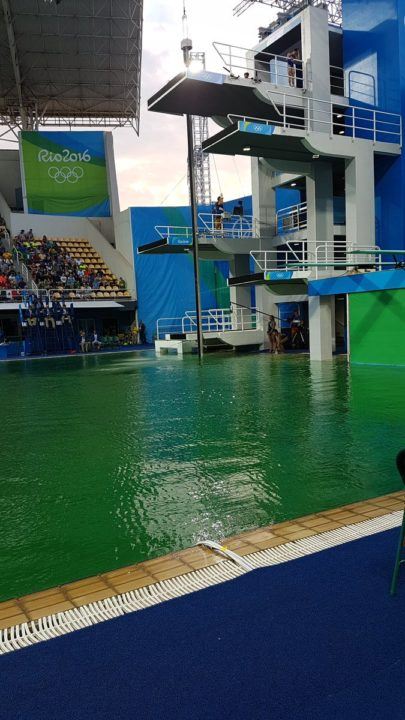The Maria Lenk aquatic facility used for diving at the 2016 Olympic Games in Rio attracted enormous attention for both the athletic feats taking place within it, as well as for the structure itself. In addition to construction delays leading up to the Games, through two days of diving competition this past summer, the diving pool turned a funky shade of green.
As we reported, facility management at the time confirmed that water tests found the green water to pose no risk whatsoever to athletes’ health, however, the pool did shut down for a period of time while the issue was rectified.
Regardless, Tokyo 2020 organizers and FINA, swimming’s world governing body, are adamant that the Olympic aquatic facility to be used four years from now will not be subject to the same issues.
“I visited the place where they are beginning to build the new swimming pool and… it will have all the requirements for an excellent championship because the last condition in Rio was different,” FINA President Julio Cesar Maglione said. “We are sure that it will be fine here.” (Reuters)
Despite rising cost concerns, Tokyo organizers are reportedly proceeding with the plan to build a brand new pool near the city’s existing Tatsumi International Swimming Center. Last month we reported how, while visiting with Tokyo governor Yuriko Koike and Japan Swimming Federation President Tsuyoshi Aoki in Japan, FINA Executive Director Cornel Marculescu elaborated on his vision for the 2020 Olympic Games’ aquatics venue.
Even with cost concerns being brought to governmental attention by a Tokyo cost-cutting panel, Marculescu insisted that a new aquatic venue is necessary not only for the competition of the Olympic Games, but for a post-2020 legacy.
Instead of considering the use of the existing Tatsumi International Swimming Center, Marculescu wants Tokyo 2020 organizers to move forward with the construction of an entirely new facility with an estimated price tag of ¥68.3 billion (~$655M). To reduce costs, Marculescu did offer up some advice to Tokyo organizers during his visit.
Marculescu first suggested lowering the height of the facility’s roof. Then, the FINA board member moved on to seating, as Marculescu said reducing the number of spectator seats is one way to shrink expenditures.
